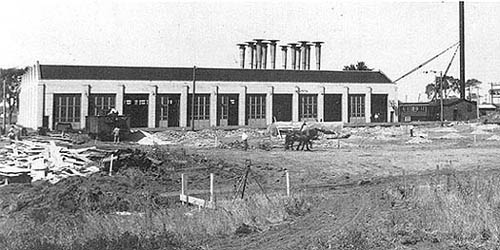
In this 1930 photo, the
Skokie Shops "complex" consisted only of one building. Site
clearance and excavation for the second building is still
underway using "horse" power in the most literal sense! This
original Skokie Shops building lasted until 2000, when it
was demolished after a new shop facility was finished.
(Photo from the Chicago Transit
Authority Collection)
|
Skokie
Shops
Oakton Street and Hamlin
Avenue, Village of Skokie
Service
Notes:
|
Located:
|

|
Yellow Line:
Skokie Swift
|
|
Services:
|

|
All
routes
|
Quick Facts:
Address: 3701 W. Oakton
Street
Established: 1926
Shop Area: 236,700 square feet
Yard Area: 1,412,625 square feet
Rebuilt: 2000
Status: In Use
Rail vehicles' regular maintenance - inspections, cleaning, etc. -
can be carried out at one of the eleven shops located at the end of
nearly every line. But for heavy repair work and overhaul, rapid
transit equipment must be taken to the famous Skokie Shops.
Rail maintenance takes the equivalent of about 1,760 people, or
just under two persons per vehicle during peak hours. About 3/4 of
staff are assigned to vehicle maintenance and the other 1/4 to
non-vehicle maintenance, though due to contract work and materials,
cost is equally divided among these functions.
In 1925, the Niles Center Line of the Chicago Rapid Transit
opened, running from west from Howard
through largely unbuilt portions of Evanston and Niles Center (later
Skokie), then north to a terminal at Dempster.
In 1926, the North Shore Line's Skokie Valley Route joined the CRT on
those tracks, running north of Dempster
to Waukegan, Milwaukee, Libertyville and Mundelein. The "L" was
always in need of new, larger maintenance facilities and the
wide-open spaces around the Niles Center Line seemed an ideal
location.
In the late 1920s, a paint shop was built at Niles Center, between
the tracks and Oakton Street, and between the North Shore Sanitary
Canal and East Prairie Road. This was the first of ten buildings to
eventually occupy the 15-acre site. When completed, the shop complex
was able to handle all overhaul and heavy maintenance work which was,
at the time, spread out at the four division's widely-spaced
facilities: Hamlin Shops (Lake Street
Division), Wilson Shops (North Side
Division), 61st Street (South Side
Division), and Throop Shops (Metropolitan Division). In 1930, a
second building was constructed to handle general rehabilitation
activities. The Depression put a stop to further plans for
expansion.
When the CTA® took control
of the CRT's physical plant, the tools and facilities for maintenance
and rehabilitation were outdated and were an immediate target for
improvement. The most modern facility they acquired were the Skokie
Shops, then already over a two decades old. The outlying shops were
even worse, the oldest of which dated from the 1890s. Skokie was only
equipped to do painting and basic car body work (chiefly limited to
carpentry). The tools for maintenance and rebuilding were scattered
around the four outlying shops and were almost of the same vintage as
the shops.
One of the CTA's® first
moves was to relocate the best of the heavy maintenance tools and
machinery to Skokie, as well as all the skilled union craftsmen that
came with them. There was a considerable influx of personnel and
equipment into Skokie Shops around 1952, which allowed some of the
heavy maintenance tasks at the other locations (Wilson,
Hamlin, 61st,
etc.) to end. Some Surface Division stock was also handled at Skokie
Shops, which may have been an attempt by
CTA® management to blur the
lines of distinction between the surface and rapid divisions in the
newly merged authority, an attempt to create "one big, happy family".
Over the years, bus work has been done at Skokie, including painting
of motor buses and trolley buses. As late as the late 1970's, GM
buses were still at Skokie for body and paint work. Shortly
thereafter, the regular flow of bus work to Skokie dissipated.
Over the years, they concentrated on updating and modernizing the
tools and facilities. In addition, with the new types of cars that
the CTA® took on over the
decades, the transition was made from carpentry and blacksmithing to
aluminum and stainless steel fabrication and welding; from the slow,
primitive wheel turning that required the wheel and axle sets to be
disassembled from the trucks to a modern, computerized,
under-the-floor wheel turning machine that can reprofile all wheels
on a train in place in just a matter of a few hours. Propulsion
control, signaling and auxiliary system packages have progressed from
simple electromechanical devices to modern, sophisticated electronic
and microprocessor technology.
In the mid- to late-1990s, the
CTA® embarked on a major
renovation and modernization of the Skokie Shops. A new
administrative building was constructed, along with new shops for
parts overhauling and rebuilding. A new inspection and maintenance
building was added with state-of-the-art facilities for painting,
rewiring, rebuilding, and most other heavy maintenance work.
Unfortunately, as part of this modernization, the original 1926 shop
building was demolished to make room for additional parking.
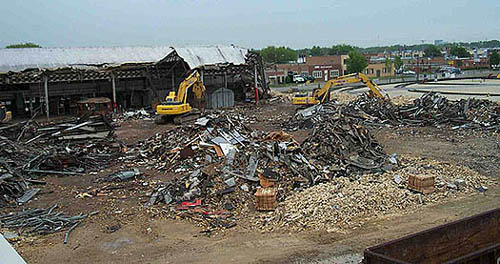
In the Spring of 2000, the
oldest of Skokie Shop's buildings, dating to the complex's
opening, was razed. The facility had long since ceased to
handle cars, having been replaced with a new car maintenance
facility. A parking lot has been built on the
site. (Photo courtesy of the
Chicago Transit Authority)
|

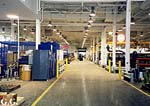
|
skokieshops01.jpg
(68k)
The new machine shop at Skokie. Repair and fabrication of
various electrical and mechanical components is done
here. (Photo by
Graham Garfield)
|
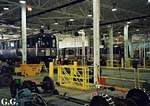
|
skokieshops02.jpg
(63k)
The inside of the new car maintenance facility, with cars
3099 and 2947 in for work, in August 1999.
(Photo by Graham Garfield)
|
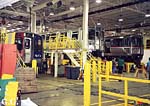
|
skokieshops03.jpg
(71k)
A mix of cars inside the Skokie Shops car maintenance
building - a 2400-series,
a rehabbed 2600-series,
and an unrehabbed 2600-series
- in August 1999. (Photo by Graham
Garfield)
|
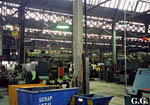
|
skokieshops04.jpg
(53k)
Inside the old car maintenance building, used for various
mechanical repairs in its final days. (Photo
by Graham Garfield)
|
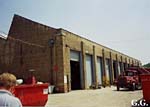
|
skokieshops05.jpg
(33k)
Outside the original Skokie Shops maintenance building in
August 1999, with less than a year until demolition.
(Photo by Graham Garfield)
|
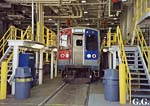
|
skokieshops06.jpg
(64k)
A 2400-series
car inside the modern maintenance facility at Skokie Shops
in August 1999. (Photo by Graham
Garfield)
|
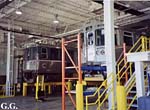
|
skokieshops07.jpg
(55k)
Car 2652, back from its rehab, and car 2948 are in for a
little maintenance in August 1999. (Photo by
Graham Garfield)
|
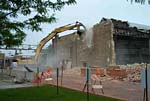
|
skokieshops08.jpg
(82k)
The original Skokie Shops meets the wrecking ball in May
2000. (Photo courtesy of the Chicago Transit
Authority)
|
Due to the large number of
additional photos of trains at Skokie Shops, a separate rolling stock
photo page has been established. To see photos of rolling stock in
Skokie Shops and Skokie Yard, click here.












